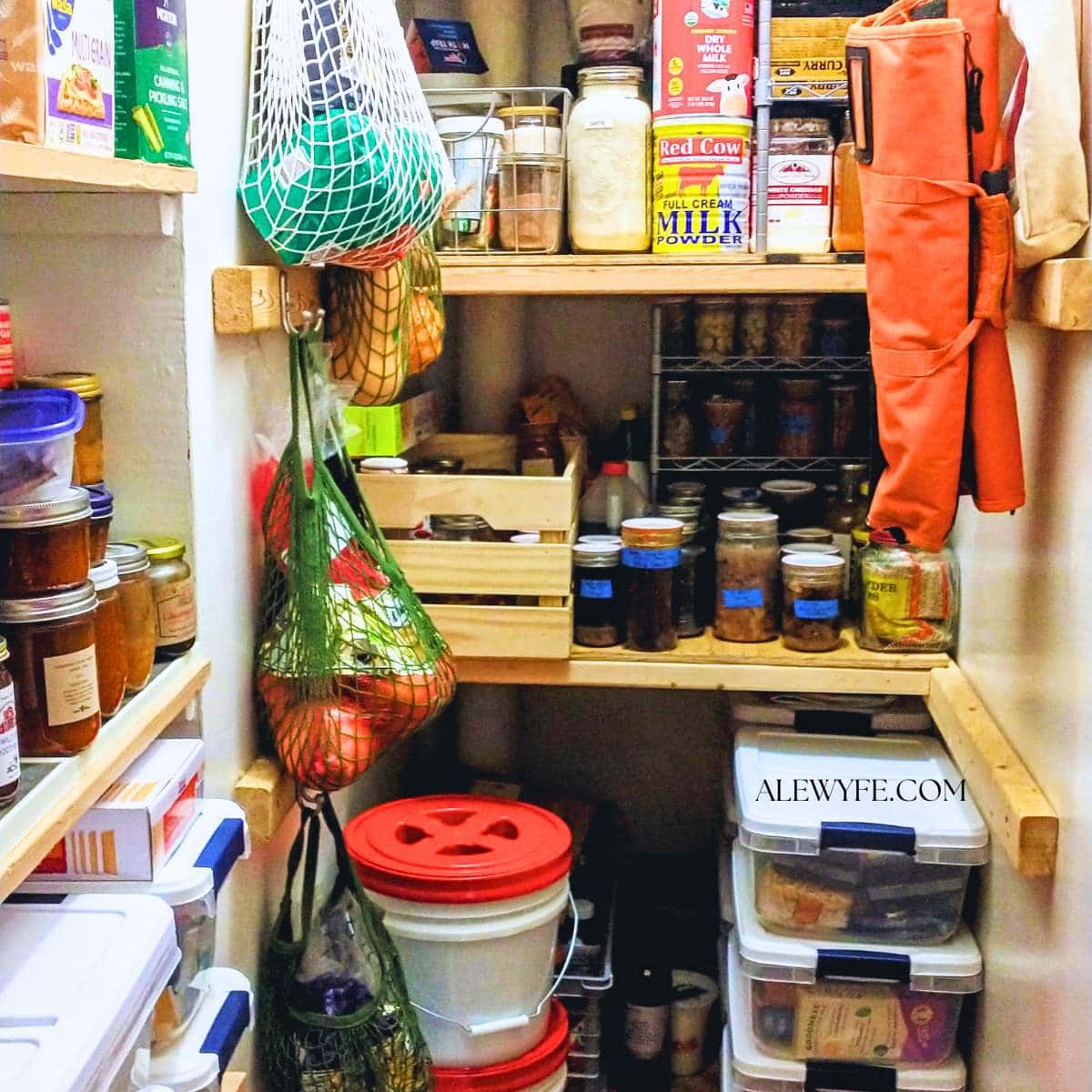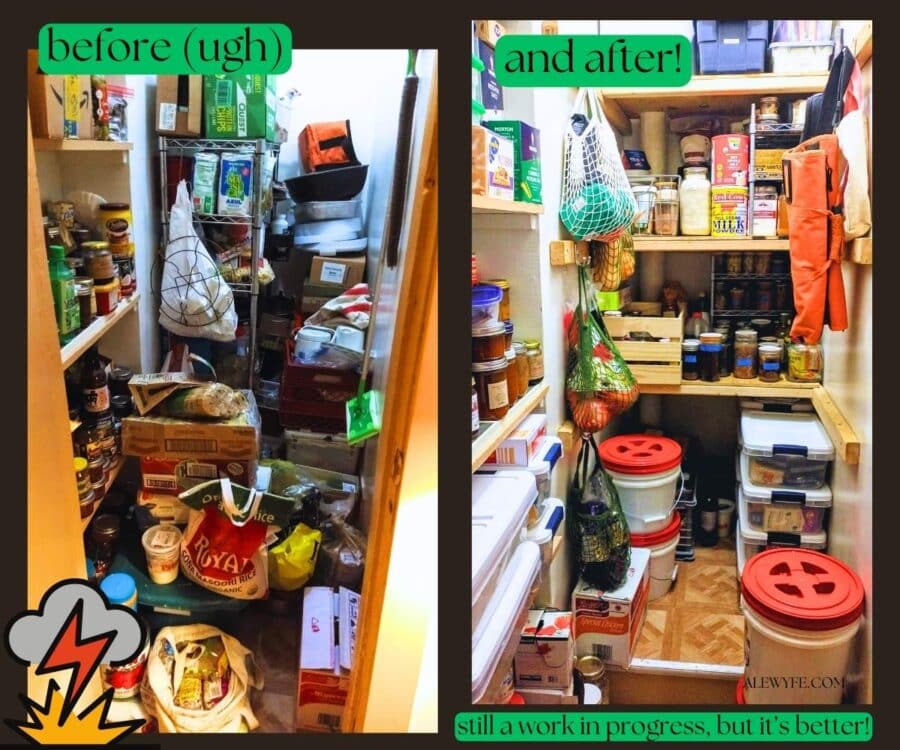SUSTENANCE: Building a Deep Pantry
- FIFO is LIFE-O
- You can’t prepare for EVERYTHING.
- Shop Sales, and Shop Seasonally to Build Your Deep Pantry
- Store your Stash Safely!
- Want More Food Storage Info?
- Related Articles:
eto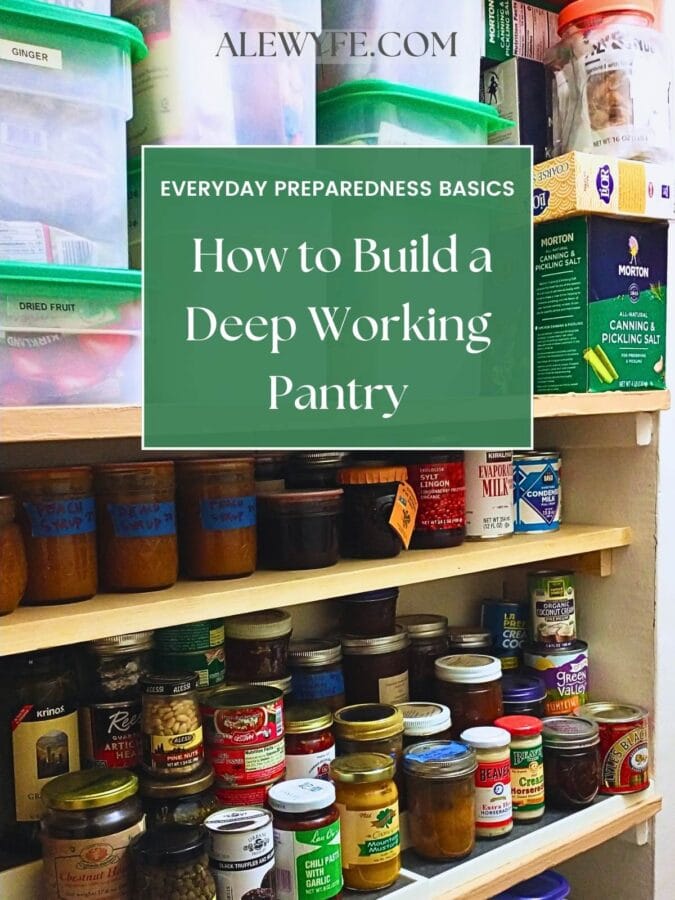
If you didn’t know that we weren’t Morman or “zombie preppers”, looking in our pantry wouldn’t convince you otherwise (we’re neither, btw). But still, we believe in keeping a deep working pantry whenever possible. And you should too! Are you curious about building a deep pantry, or even what that means?
Don’t know where to begin? No worries, it’s not hard, and we’ll show you The Way.
In our house, you’d first have to figure out even WHICH pantry you’re looking in…
- The kitchen shelves with everyday staples that we reach for daily, like baking mixes and small amounts of grains and dried vegetables, along with seasonings and spices and coffee and tea?
- The main pantry closet near the kitchen, with the everyday canned goods and jams and pasta and alllll the ramen collections (and buckets of dog food and treats)? Any fresh kraut or other fermented foods hang out here too in all but the hottest months…
- The canned venison and pickled wild mushrooms stashed under the office futon, or the bulk buckets and cases of Costco canned goods in the basement (bought seasonally when items are on sale) and the overflow of the home canned goods like meals-in-a-jar, soups, and pasta sauces?
- Oh yeah, or the freeze-dried just-add-water meals and snacks in bins with the rest of the camping gear (mostly, those are for camping, but it’s nice to know that they’re there… although a pricey way to acquire food storage that I don’t recommend unless you need them for backpacking or money is no object)?
- Or the chest freezer with its wild venison and fish and frozen veggies… and both homemade and commercial convenience foods like frozen pizza and/or dough, dumplings and pierogi, filled pasta, and pot pies?
The answer is that they’re all part of our working deep pantry!
So don’t think you need one special dedicated Pinterest-worthy place to keep everything.
What, we just like food, okay? I’m pretty sure we’re at least three months ahead in our YNAB grocery budget category if you count on-hand stuff, more if we eat more boring meals or had to live on rice and beans, so now we can just buy stuff when it’s on sale instead of when we run out… (more about that later)… and I wouldn’t have it any other way if I can help it. If you have a bigger family than ours (or a teeny tiny budget- but trust me, ours is pretty small and this helps stretch every bit of it), you might not be able to keep this much on hand. Or you live in a small apartment and don’t have space or a freezer. And that’s ok!
But everyone, if at all possible, should try to have at least two weeks worth of groceries and staples on hand, both to tide you through everyday inconveniences and even a minor emergency. They should be a mix of shelf-stable and fresh, and preferably things that are easily prepared and most importantly, that you already eat regularly. This is a good idea whether the emergency is personal, like an illness or injury that keeps you from going to the store, or a job loss or missed paycheck… or larger, like a natural disaster, which are unfortunately a more frequent occurrence these days!
With the way grocery prices are anymore, it’s had a better return than my savings account right now!
We don’t buy more than we can eat before it goes bad, and we eat what we buy, so this isn’t wasteful or terribly weird, as far as I am concerned, even though it seems that way to most folks… although certainly a lot less strange now that we’ve survived 2020 and everything after (if you’re reading this, that is. If you didn’t survive, I hope you’re not reading it or we’ve all got bigger problems than my dark humor can cope with, yeah?). It’s also helpful if like us, you have a wildly variable or seasonal income, or have tenuous job security (which, really, who doesn’t these days?).
FIFO is LIFE-O
That said, in my recent rough pantry clean out and inventory, I did find some very ancient oxidized mulberry-lime jelly & a jar of zucchini relish with a bad seal that should go in the compost, and some pickled eggplant and dried apples that are “use it or lose it” and might just be chicken treats or more compost at this point? Pobody’s nerfect, but FIFO is life-o!
FIFO, if you aren’t from the restaurant or food retail world, means, “First In, First Out” and is a standard system of rotation for managing perishable stuff. It means you put the new cans behind the old ones, eat the lettuce that’s a little less than perfect before getting into the new stuff from the garden or grocery, and check dates on things periodically. If you share a pantry with others who may not be as careful as you, make it easy- mark things with sharpie and painters tape like a restaurant kitchen, or use can rotator shelves that manage this for you.
You can’t prepare for EVERYTHING.
Don’t think you have to build yourself a bunker (though if that’s your thing and you have the resources, go right ahead I guess?). Don’t worry about trying to prepare for every possible scenario. You can’t. Odds are if things are that bad even your bunker full of beans isn’t going to save you. Your pantry is for ordinary, everyday struggles. And unexpected guest joins you for dinner? Or maybe the whole scout troop or your extended family shows up at your house? And they’re hungry? No problemo. You or a partner loses a job, is sick, another pandemic hits, or a natural disaster… there are unfortunately a million reasons that you would be well-served by having well-stocked shelves in your home larder.
Obviously not everyone has the luxury of being able to afford anything extra, but most people can find a little bit of wiggle room if they’re not already on a bare-bones budget (and believe me, I’ve been there, calculating the price of every item in the grocery basket and putting things back so I didn’t overdraft my account… it’s rough, and it’s rough out there for a lot of people, I know). But if you do have stable housing with any amount of storage and a little bit of wiggle room in your budget, it’s irresponsible to not keep at least a couple weeks of shelf-stable foods on hand, even if it means buying the cheaper brand or skipping some luxuries for a bit until you have built up your dry-goods inventory with some shelf-stable foods.
Shop Sales, and Shop Seasonally to Build Your Deep Pantry
So you’ve decided this is a good idea, and you want to start building your deep pantry stash. You don’t have to go out and buy it all at once, and probably shouldn’t… just get a little extra of things you like each time you shop until you could miss your weekly grocery trip for a couple weeks without noticing. Now, you’ve bought yourself not just peace of mind, but also are primed to save money going forwards. How? Instead of buying things when you need them (because you ran out), you buy them when they’re less expensive. Your favorite mayonnaise, canned soup, or pasta brand goes on sale? Buy several, or enough to last either until it would be out-of-date or will be likely to be on-sale again (lots of things have seasonal sales and you can stock up if you have space).
This may sound obvious, but don’t buy things JUST because they’re on sale, unless you or someone in your family likes them. I don’t care how good the sale on canned peas is, I’m not buying them because we both think they’re gross. Frozen peas? Delicious. Dehydrated frozen peas? Fine, and much better than canned (and take up less space). If I wake up in a Fallout New Vegas scenario and they’re the only loot in town? Ok, fine, I’ll eat the glowing mush. But otherwise, blech! Maybe you love canned peas and think I’m daft, but can’t stand sauerkraut or canned mushrooms… that’s ok, more for me. Just make sure someone in your household likes the things you are buying or have stored, otherwise, take it directly to your nearest food pantry, soup kitchen, or Love Fridge to get it to someone who will use it!
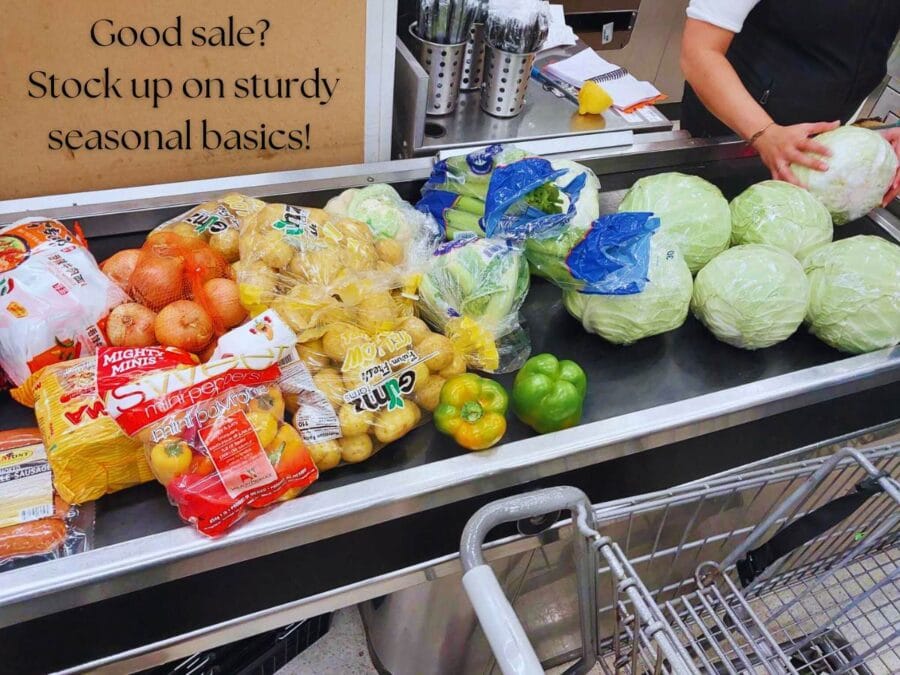
Eat like your grandparents and stick to seasonality (with modern variations)… make a big batch of kraut in the fall when the cabbage harvest comes in, or when it’s on sale again around St. Paddy’s day (although cabbage is usually pretty cheap year round). Can or freeze a batch of turkey soup and stock at Thanksgiving when turkeys are on sale. Buy as many baking supplies as you have room to suitably store and use during the holidays when nuts, chocolate chips, and other baking staples are often discounted (store nuts in the freezer and they’ll last all year).
Carrots last FOREVER in the fridge, so I never buy less than a five lb bag as they’re cheaper that way, and if they start to get wonky, I make a big batch of carrot soup, carrot slaw or kraut, or grate them and put them in the dehydrator for shelf-stable soup fixin’s. Buy pumpkins and squash in the fall and put them somewhere cool and dark and you can enjoy them months later (or roast a giant batch, cube or puree them, and freeze them for easy soups and baking). Right after Halloween is a perfect time to pick them up for a song! Buy extra apples in the fall when they’re freshly picked and inexpensive, and can apple sauce and pie filling to enjoy later, instead of buying cold-storage or imported apples in the spring and summer.
Store your Stash Safely!
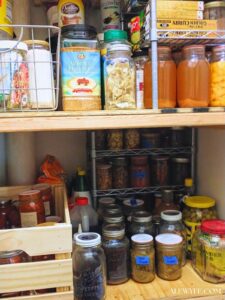 All that said, it’s a false economy if you buy all this food and let it go bad. I’ve battled pantry moths in the past, and it’s NO FUN… and they can come in on any packaging from the store, bag of grain or rice or pasta or cereal… it’s a big reason why I’m a fan of decanting stuff into glass or plastic storage containers, and using mylar bags and bulk buckets (with Gamma Seal lids for easy access).
All that said, it’s a false economy if you buy all this food and let it go bad. I’ve battled pantry moths in the past, and it’s NO FUN… and they can come in on any packaging from the store, bag of grain or rice or pasta or cereal… it’s a big reason why I’m a fan of decanting stuff into glass or plastic storage containers, and using mylar bags and bulk buckets (with Gamma Seal lids for easy access).
Pantry moth eggs are almost impossible to see, but removing the outer layer of packaging (especially cardboard boxes) is the first layer of defense. Pantry moth larvae can chew right through ziplock and other plastic bags, but glass, hard plastic (with an airtight seal), and mylar bags will keep them out.
Vacuum sealing or using oxygen absorbent packets is another layer of protection to keep your food safe from these pests… and to isolate them if any are present.
Another great strategy is to freeze-treat things like flour, rice, bulk grains, and spices, but can be hard if you are buying in bulk and don’t have a large freezer… but it’s especially helpful if you are doing the “slow and steady” approach to building up a pantry surplus. Most people can make room for a couple bags of rice or a regular bag of flour in their freezer. Leave it in there for two weeks if you want to make sure that all pest eggs are killed.
I know, this sounds gross but trust me, all grain products whether from the bakery or homemade might have bug eggs hiding somewhere in the grain itself or on the packaging… they mostly won’t hurt you but they are gross and will spoil a lot of food in a hurry if you let them loose in a pantry with open packages, and once the pantry moths or weevils are in your house, it’s really hard to get rid of them if you haven’t stored things properly to prevent them from getting into everything. After you freeze your dry goods, let them come up to room temperature first and make sure they are free from condensation moisture before storing them in an air-tight container, like one of the ones below:
Bail-Top Canisters and Jars with Gaskets:
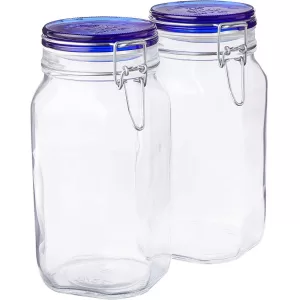
You can buy these new or often find them at thrift stores and garage sales. Fancy ones from Le Parfait, Bormioli Rocco, and Kilner with clamps, or Weck jars with clips can be used for water bath canning or storing ferments like kraut or kimchi, but also make great bulk pantry storage. For dry storage the generic ones are also useful.
You can buy replacement rubber or silicone seals for these online or at some kitchen supply stores, so don’t pass on that cheap thrift store jar set just because the rubber seals are missing or dried out! I’ve gotten a lot of these jars this way cheaply.
They’re inert glass (won’t leach anything into your food) and will last forever… as long as you don’t drop them. Don’t drop them… so if you have lots of kids in the house this might not be the way you want to go, at least not with anything they might want to use or can reach.
Recycle packaging:
This is the greenest and most budget-friendly option. Save bulk plastic wide mouth containers (like the ones from mixed nuts, snack mix, some rice and couscous, etc) and reuse them for storing your bulk goods. Pasta sauce and other jars with resealable lids, or instant coffee or drink mix jars and popcorn or cookie tins with tightly fitting lids are also great.
Remove labels by soaking in hot soapy water, hot water and OxiClean or P.B.W. (Powdered Brewery Wash, a stronger unscented cousin of OxiClean that homebrewers use for cleaning equipment and bottles and is also fantastic for cutting grime and removing labels). Goo Gone followed by strong dish detergent is good for very sticky labels that even those first two treatments can’t remove. Then label with painter’s tape and sharpies, or stick-on chalkboard labels and chalk markers, or a label maker for a polished look.
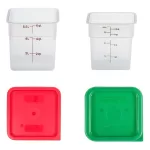 Cambro Containers:
Cambro Containers:
Anyone who’s worked in a kitchen is familiar with these- they’re the Tupperware of the restaurant world, and super durable.
- Pros: they’re modular, stackable, sturdy as heck, and the square ones make efficient use of shelf space.
- Cons: They’re expensive if you buy them new, and may or
may not be air-tight (depends on who you ask and also which kind you buy).
Plastic Pantry Canisters:
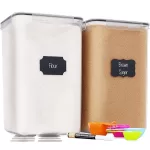 These are pretty ubiquitous, and come in big matching sets with cute chalkboard labels. The lids are airtight and snap closed, and some have pourable tops (especially the cereal containers) and easy to hold shapes.
These are pretty ubiquitous, and come in big matching sets with cute chalkboard labels. The lids are airtight and snap closed, and some have pourable tops (especially the cereal containers) and easy to hold shapes.
The downside? Even though they won’t shatter like a glass jar, these have not been super durable in my experience. I bought some of these in the last two years, and some already have lids that have broken or are showing wear (where they snap closed).
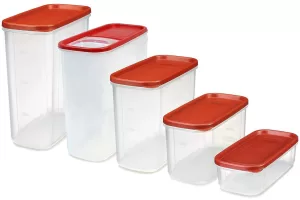
You might be better served to invest in the pricier OXO Pop containers or that old standby, Rubbermaid, like these:
The other consideration for using plastic pantry containers is that they’re bug-proof, but not necessarily rodent proof. They’ll keep mice out but larger rodents will get in if they want to… hopefully this isn’t an issue for you, but if you have things stored in a garage or live somewhere where this can be a problem (an old farmhouse, a rustic cabin, etc), it’s worth considering.
I lost a couple of my favorite bulk storage containers several years ago when a rat got into the pantry at the old rowhouse where I was staying and tried to chew in (aaaaaaa gross). I hope none of you need that advice but you never know? If that’s something you need to worry about, stick with glass and metal containers are a better option (and a roll of hardware cloth or an exterminator to solve the problem)… or do what I did – MOVE, lol.
Food-grade buckets and Gamma-Seal lids:
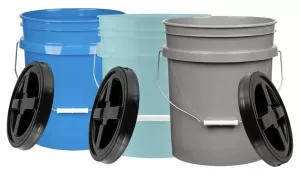 Buy new food-grade HDPE plastic buckets (Home Depot, Amazon, and home brewing stores often have these) or source them from a commercial bakery or deli (they may smell like pickles or be coated in frosting, but they’ll be free). The screw-top gamma lids are expensive but sturdy and last forever.
Buy new food-grade HDPE plastic buckets (Home Depot, Amazon, and home brewing stores often have these) or source them from a commercial bakery or deli (they may smell like pickles or be coated in frosting, but they’ll be free). The screw-top gamma lids are expensive but sturdy and last forever.
I put these on any bulk bucket we access often (with separate buckets for all-purpose flour, sugar, pasta, rice, and dog food and treats. You can mix categories of foods in the buckets too as long as there’s nothing strong smelling in the mix. You can get away with regular heavy duty lids with gaskets, but they’re hard to open. Pick up a bucket opener tool like this one if you’re using the regular lids:
